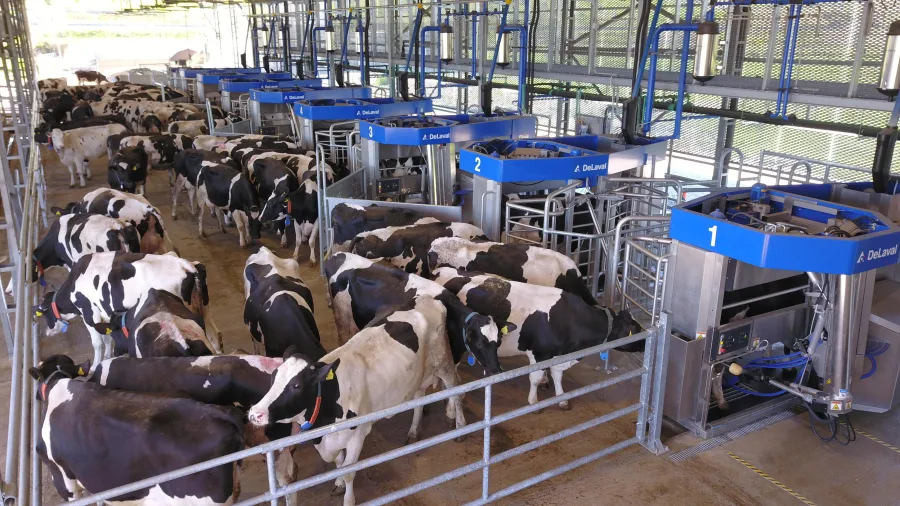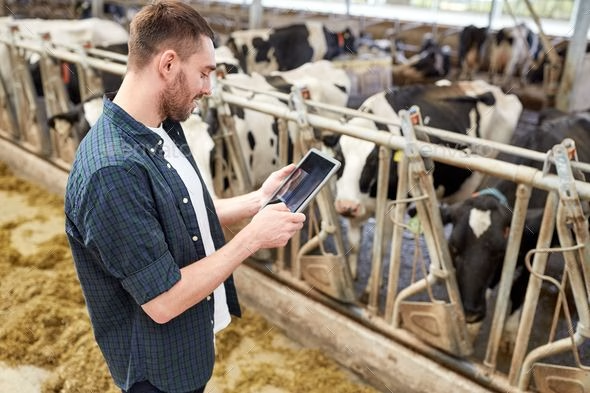The Dairy Business Innovation Act of 2025 promises a game-changing boost to the industry. With proposed funding jumping from $20M to $36M annually, this bipartisan effort could revolutionize your operations. Discover how this Act might reshape your farm’s future, from robotic milkers to artisanal cheese.
Summary:
The Dairy Business Innovation Act of 2025, initiated by Senators Tammy Baldwin and Marsha Blackburn, aims to boost support for American dairy farmers by raising annual funding from $20 million to $36 million. This bipartisan legislation promotes innovation and modernization, helping farmers to diversify and grow their businesses. It supports areas like business development, product innovation, marketing, and facility upgrades. With backing from industry leaders, the Act aims to strengthen the competitiveness of small dairy operations, especially those facing market challenges. Farmers should consider how to use this support to ensure a stable and successful future in a tough market.
Key Takeaways:
- The Act proposes to increase annual funding for the Dairy Business Innovation Initiatives (DBII) program from $20 million to $36 million.
- It aims to support American dairy farmers and processors in innovating, diversifying, and modernizing their businesses.
- The DBII program offers assistance in business development, product innovation, marketing, and facility modernization.
- To date, the program has supported over 250 dairy farmers and processors in the Midwest, including 109 in Wisconsin.
- The legislation has garnered support from key industry organizations such as the International Dairy Foods Association and National Milk Producers Federation.
- It focuses on diversifying dairy product markets, promoting business development, and encouraging the use of regional milk production.
- The Act could help dairy farmers integrate new technologies like robotic milkers and advanced herd management software.
- It aims to address challenges such as market volatility, labor issues, and inflation faced by the dairy industry.
- The legislation is particularly beneficial for small dairy operations struggling to remain competitive.
- It builds on the success of the original DBII program created in the 2018 Farm Bill.

U.S. Senators Tammy Baldwin (D-WI) and Marsha Blackburn (R-TN) have introduced the bipartisan Dairy Business Innovation Act of 2025 to bolster support for American dairy farmers and processors. The Dairy Business Innovation Act 2025 aims to strengthen the Dairy Business Innovation Initiatives (DBII) program, supporting an industry facing significant challenges.
Funding Boost for Dairy Innovation
The main feature of the Act is a significant funding increase, suggesting an annual authorization raise from $20 million to $36 million. This 80% boost could provide critical resources for dairy farmers looking to innovate and grow their businesses in an increasingly competitive market.
To illustrate the potential impact of this funding increase, consider the following projected outcomes:
| Aspect | Current | Proposed | % Increase |
|---|---|---|---|
| Annual Funding | $20M | $36M | 80% |
| Businesses Supported | 250 | 450* | 80% |
| States Covered | 11 | 20* | 82% |
| New Products Developed | 100 | 180* | 80% |
| Jobs Created | 500 | 900* | 80% |
* Estimated based on proportional increase in funding.
This table demonstrates the potential scalability of the DBII program with increased funding, showing how it could support more businesses, cover more states, and create more jobs in the dairy industry.
Senator Baldwin emphasized the Act’s potential impact:
“From expanding facilities and growing their operations to improving packaging and lowering shipping costs, this program has helped Wisconsin businesses grow their bottom lines and create jobs in our rural communities”.
Regional Impact and Adaptation
The Act’s impact is expected to vary across different regions and types of dairy operations:
- In Wisconsin, where the program has already supported 109 dairy businesses, the focus is on expanding artisanal cheese production and modernizing small to medium-sized dairy farms.
- In Tennessee, the Act assists small dairies in diversifying their product lines and enhancing processing facilities to compete with more extensive operations.
- In Vermont, the Northeast Dairy Business Innovation Center has awarded grants for developing skills-based digital classes on small ruminant dairy farming and installing electric robotic manure scrapers to improve sustainability.
- In Michigan, the program has supported companies in creating value-added products and enhancing dairy export programs.
Senator Blackburn highlighted the potential for small dairies: “With many small Tennessee dairies struggling to remain open, this bill will allow these businesses to diversify and expand their market competitiveness.”
Comprehensive Support for Dairy Businesses
The DBII program offers multifaceted assistance to dairy farmers and processors:
- Business development and planning
- Product innovation and marketing
- Facility modernization and process improvement
For farmers facing fluctuating milk prices in February 2025, such as $21.27/cwt for Class I and $20.73/cwt for Class IV, this support could be vital for developing income stabilization strategies and exploring new revenue opportunities.
Industry Backing and Economic Impact
The legislation has garnered support from key industry organizations, including the International Dairy Foods Association and the National Milk Producers Federation. Gregg Doud, President and CEO of the National Milk Producers Federation, stated: “This program helps support researchers and their industry partners working to drive this innovation forward”.
The Dairy Business Innovation Act of 2025 complements existing dairy regulations and programs, offering additional support to farmers navigating a complex regulatory landscape:
- Federal Milk Marketing Orders (FMMOs): While FMMOs set minimum prices for milk, the DBII program helps farmers diversify their income streams and add value to their products, potentially reducing reliance on volatile milk prices.
- Dairy Margin Coverage (DMC): As DMC provides risk management for dairy farmers, the DBII program complements it by helping farmers innovate and potentially increase their profit margins through new products and markets.
- Environmental Regulations: The Act could assist farmers in meeting evolving environmental standards, such as Wisconsin’s 2025 Nitrogen Reduction Strategy, by providing support for modernization and sustainable practices.
- Food Safety Modernization Act (FSMA): DBII initiatives can help dairy processors upgrade their facilities to meet FSMA requirements, aligning innovation with food safety standards.
- State-Level Regulations: The Act’s regional approach allows for tailored assistance that considers state-specific regulations, such as California’s Grade A milk licensing or Wisconsin’s somatic cell count standards.
Potential Challenges and Implementation Hurdles
While the Dairy Business Innovation Act of 2025 presents substantial opportunities, it’s important for dairy farmers to anticipate potential challenges when implementing the program and accessing its funds:
- Application Process Complexity: Smaller dairy operations may find the grant application process daunting, potentially limiting their ability to access funds.
- Fund Distribution: With increased funding, there may be heightened competition for grants, potentially favoring larger or more established operations.
- Implementation Timeline: The time required to implement new innovations or modernize facilities may be longer than anticipated, affecting short-term cash flow.
- Matching Requirements: Some grants may require matching funds, which could be challenging for cash-strapped dairy farmers.
- Technical Expertise: Farmers may need to acquire new skills or hire consultants to fully leverage the program’s benefits, adding to costs.
- Regulatory Compliance: New innovations or processes may require additional regulatory approvals, potentially delaying implementation.
Modernization and Innovation Focus
In an era where technology adoption is crucial, the Act could help farmers integrate innovations like robotic milkers and advanced herd management software. This aligns with the industry trend towards precision agriculture, as seen in recent UW-Madison research on nitrogen optimization.

Looking Ahead: Opportunities for Dairy Farmers
As the bill progresses through Congress, dairy farmers should evaluate their operations and pinpoint areas for innovation or diversification to maximize potential DBII support.
- Assess current operations and identify areas for innovation or diversification.
- Explore new product development or value-added processing opportunities.
- Investigate sustainable technologies that could improve efficiency and compliance.
- Consider collaborative opportunities with local processors or fellow farmers.
The Dairy Business Innovation Act 2025 represents a significant opportunity for American dairy farmers to adapt, innovate, and thrive in a changing agricultural landscape. Financial resources and technical assistance help overcome key challenges in today’s dairy industry, potentially securing a more stable and prosperous future for milk producers nationwide.
Learn more:
- The Future of Dairy Farming: Insights for US and Canadian Farmers!
- U.S Dairy Industry Pushes for Enhanced Trade Policies to Boost Exports and Strengthen Supply Chain
- How the 2024 Presidential Election Could Reshape Agricultural Marketing Strategies
 Join the Revolution!
Join the Revolution!
Bullvine Daily is your essential e-zine for staying ahead in the dairy industry. With over 30,000 subscribers, we bring you the week’s top news, helping you manage tasks efficiently. Stay informed about milk production, tech adoption, and more, so you can concentrate on your dairy operations.







 Join the Revolution!
Join the Revolution!





